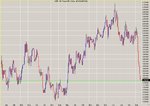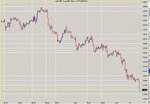Things haven't changed much in a hundred years have they:
"Disregarding the big swing and trying to jump in and out was fatal to me. Nobody can catch all the fluctuations. In a bull market your game is to buy and hold until you believe that the bull market is near its end.
Wait until you see -- or if you prefer, until you think you see the turn of the market; the beginning of a reversal of general conditions.
That is about all I have learned to study general conditions, to take a position and stick to it. I can wait without a twinge of impatience. I can see a setback without being shaken, knowing that it is only temporary.
One of the most helpful things that anybody can learn is to give up trying to catch the last eighth or the first. These two are the most expensive eighths in the world.
Everybody knew that the way to exploit a market conservatively was to take profits and buy back your stocks on reactions. And that is precisely what I falsely did in my early years, or rather what I tried to do; for I often took profits and waited for a reaction that never came.
They say you never grow poor taking profits. No, you don't. But neither do you grow rich taking a four-point profit in a bull market. You might lose your position and with it the certainty of a big killing. It is the big swing that makes the big money for you."
Jesse Livermore, who started out penniless, and became what would in todays money have been a Billionaire through trading almost a hundred years ago.
"Trading is not about how often you are right. Trading is about how much money you make when you do have a winning position."
George Soros, MultiBillionaire in todays money as well, lol.
Conversely, Market Wizard Marty Schwartz, who wrote the excellent Pit Bull, had what far too many cherish, the 70, 80% hit rate, and a NON-compounding return on his assets of 30% / month, but to keep that working he had to regularly clear out his account for market liquidity issues. Later when he tried to join the top dogs, first through Commodities Corp that was later bought out by Goldmans Sachs and supplied him with what for his style was too much money to make his method work, and later when he attempted to start his own hedge fund, both times he failed to get his scalping / very short term / high hit rate methods to work with large sums.
It's either scalp your way to a very good livelihood with a high hit rate, or go join the top dogs and forget about hit rate, maximising your risk / reward ratios instead.
If you could combine high hit rate with excellent risk / reward ratios you would be the richest person on this planet and most other galaxies out there in no time at all.


